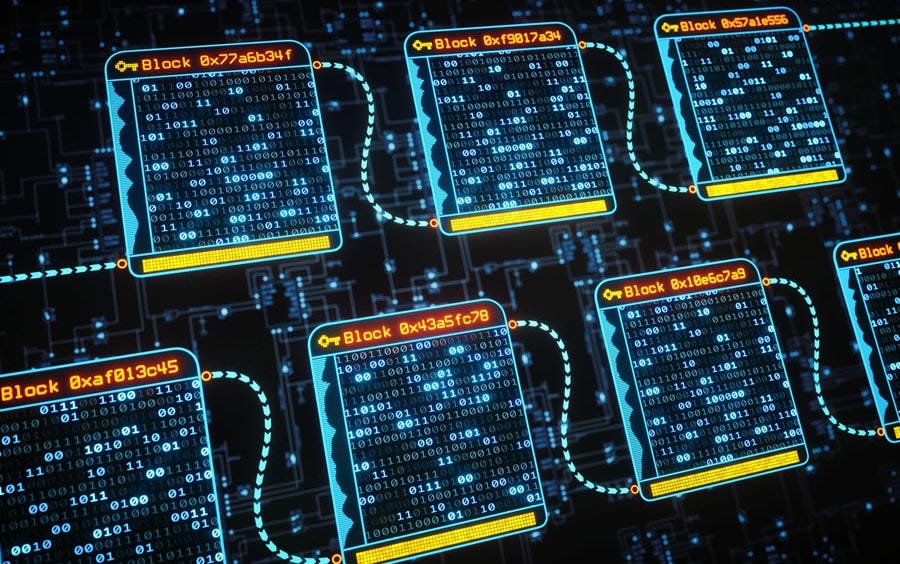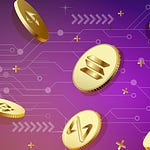This special, FREE edition of The Coles Report can be collected and owned as an NFT on Mirror by clicking HERE. A limited edition audio NFT can also be collected by clicking HERE.
Blockchains make cryptocurrencies, NFTs, DAOs, Web3, and the Metaverse possible. The technology on which blockchains are built has the potential to completely level the global economic and social playing fields. The whims, judgment, greed, and exclusive financial networks hoarded by a few are on the brink of losing their monopolized, or better yet centralized, power and control.
Have you ever shared a Google document with a peer? That document was distributed between everyone that had been given access to it. When you made changes to the copy on your end, those changes were immediately reflected to the document, and could be seen by all participants in real time. The document was distributed, and was accessible to everyone that had rights to edit, read, or write to it. Any changes made could be seen by whomever it was shared with.
Blockchains are also distributed. For example, any changes made to the Bitcoin blockchain can be seen by everybody. The entire history of transactions that have been made to the blockchain are publicly accessible. When new changes are made, everyone can see those changes. The transparency and public record of the Bitcoin blockchain is one of the features that give the public confidence in it as a digital form of currency.
[..] there are at least 1,000 different blockchains.
A common misconception is that there is a singular phenomena called “The Blockchain”. In actuality, there are at least 1,000 different blockchains. Bitcoin operates on its blockchain. Ethereum operates on its blockchain. Cardano operates on its own blockchain. There are numerous blockchains. Each one serves a specific purpose for its developers and users.
The Structure Of Blockchains
While there are many different blockchains, there are four different types of blockchain structures. They are public blockchains, private blockchains, hybrid blockchains, and consortium blockchains.
Public blockchains are open and available to anyone with internet access. This type of blockchain is ideal for cryptocurrency and document validation. Private blockchains are used by small networks within an organization. Permission must be granted to access a private blockchain. They are commonly used for asset ownership and supply chain.
Hybrid blockchains combine public and private blockchain technology. In this case, a public network is set up alongside a private network. This allows control of who has access to certain data, and what is publicly accessible. These types of blockchains work well with real estate and medical records. Consortium blockchains are similar to hybrid blockchains. They have both public and private blockchain features. However, their access is restricted to a specific group or members. Having members ensures that no single entity controls the network. Consortium blockchains are useful for supply chain, banking, and research.
Genesis
Blockchain was originally described in 1991 by a group of researchers. It was intended as a way to timestamp digital documents so that they couldn’t be backdated or tampered with. This would be similar to a notary. The original blockchain technology was adapted in 2008 by Satoshi Nakamoto to create bitcoin.
[..] immutable, which means that it’s irreversible
A blockchain is a distributed database. We’ll focus on public blockchains which are completely open to anyone. Once data is recorded on a blockchain, it is nearly impossible to change. This is why blockchain technology is said to be immutable, which means that it’s irreversible.
The type of data that the Bitcoin blockchain stores is transaction details. It is more or less a ledger that documents every single transaction that happens on its network. When Person A sends one bitcoin to Person B, the transaction details (including wallet addresses, timestamps, etc.) are stored on a “block” along with other transactions. Each block on the Bitcoin blockchain is limited to 2,400 transactions, and typically takes around 10 minutes to process, or validate.
Hash It Out
In addition to the data that’s stored, a “block” also includes something called a hash. A hash is a unique, identifying number for the individual block. It functions sort of like a fingerprint, and identifies a block and all of its contents. Bitcoin miners use powerful computers to solve cryptographic puzzles. When these puzzles are answered correctly, the only hash that makes a block valid is revealed.
Once a block is validated, it is closed, and the cycle repeats. In addition to its own unique hash, the top (or header) of each new block also includes a reference to the hash of the previous block. Remember, the hash is like a fingerprint. This connection between new and previous blocks is what links, or chains, all of the blocks together. Hence the term “Blockchain”.
So now we have data that is stored on blocks. Each block has its own unique hash that is output through the work of miners. Once a block is validated it is added to the blockchain. Each new block that gets validated references the hash of the previous block.
Nodes Hold It All
The blocks are stored on a peer-to-peer network of nodes. Nodes are servers and computers (or mobile phones) that run network software. Miners are simply a specialized type of node. There are also other types of nodes in the network. All in all, nodes form the infrastructure of a blockchain. They store, spread, and preserve the blockchain data. Theoretically, the blockchain exists on nodes.
There is no one, central authority that controls the data or the system.
Since nodes also verify the blockchain data, the system is considered decentralized. There is no one, central authority that controls the data or the system. Since all of the nodes have a copy of the entire blockchain, they all can see when changes are made to it. If someone were to try to hack the system by changing the data on a block, the nodes would recognize the discrepancy and not validate the block. All legitimate transactions within that block would be moved to another block for validation.
To sum it up, blockchain technology allows for trustless, decentralized, peer-to-peer networking that does not rely on governments, banks, corporations, or other centralized third parties. Trustless means that the participants involved do not need to know or trust each other for the system to function. As stated earlier, Bitcoin is one of many blockchains. In the case of bitcoin, its blockchain protocol was designed for payments and transactions. It is a pure digital currency.
Smart Contracts
Ethereum is another decentralized blockchain platform. Ethereum brought smart contract functionality to the industry. Smart contracts are software programs that are stored on a blockchain that run when certain conditions are met. The Ethereum blockchain is designed such that developers and organizations can build their own decentralized applications, or dApps, on top of it. The Ethereum ecosystem is fully programmable and scalable. This has led to the creation of dApps in numerous areas including NFTs, DAOs, and decentralized finance.
With smart contracts the execution of agreements and workflow can be completely automated without the need for third parties or human intervention. Imagine a vending machine that operates purely on software code that is run on a blockchain. There could be a condition that says if a person puts $1 into the machine, and pushes button A1, release a bag of peanut M&Ms. Another condition could say when the machine is out of peanut M&Ms, automatically send an order to the supplier for more peanut M&Ms.
On the supplier’s end, a condition could be called to load more peanut M&Ms onto a fully automated delivery truck. A program could then enable that delivery truck to go to the location of the vending machine. From there, an automated robot could be prompted to load the new peanut M&Ms into the vending machine. Smart contracts could allow such an automated system to exist.
Smart contracts are simply code, or software programs, that automate the execution of agreements and workflow when certain conditions are met.
The Birth Of A New Nation
So now you can see how powerful blockchain technology is. Blockchains store data and transactions in a decentralized and trustless way. Some blockchains also allow for software code (or smart contracts) to be stored on them. This opens the door for the creation of applications that enable economic and social freedom like modern society has never known.
There are numerous applications that have been born from blockchains and smart contracts. Decentralized finance allows for lending, borrowing, exchanging, and earning yields without the need for banks or third parties.
Imagine being able to take out a loan for your small business without having to deal with the subjectivity of approval and interest rates from traditional banks. Or, how about earning interest on your funds that is 3-5 times more lucrative than a traditional savings account? Maybe you’re a trader who desires to play the higher stakes game of day trading without the need for a brokerage account. All of these options exist today. Blockchains such as Ethereum, Cardano, Polkadot, Avalanche, and Solana offer applications that have ushered in this decentralized era in finance.
DAOs are another type of application available on blockchains. DAOs are decentralized autonomous organizations that allow groups of people, or communities, to utilize blockchain and smart contract technology to reach coordinated goals. A DAO operates very much like an LLC, except you don’t have to go through any of the local, state and federal government red tape to set one up. In fact, you could spin up a fully functional DAO in a matter of minutes.
DAOs have no central leadership and are governed by the community that is built around it. All community members hold DAO tokens which give them voting power and ownership interest in the organization. DAOs could be built around anything from starting a book club to purchasing real world assets, such as land and buildings, to raising funds for a political lobby. The sky is truly the limit. Bring a community together around shared goals and interests, and you have the makings of a DAO. Most DAOs today run on the Ethereum blockchain.

Non-Fungible Tokens
NFT stands for non-fungible token. It is a type of digital token or asset. When you purchase an NFT you buy the rights to that specific asset. There are art-based NFTs, music-based NFTs, and NFTs that represent digital land and other assets. There are also NFTs that offer various types of utility. For example, Gary Vaynerchuk’s NFTs offer access to him.
Non-fungible means that an NFT can’t be changed or split up; and no two NFTs are exactly the same, even if the difference is just in the ID numbers. A token is just a small piece of data that you own that doesn’t change with time. Of course, that data lives on a blockchain. That piece of data, which represents NFT ownership, resides at a crypto address. If you own the crypto address, you own the NFT. It’s all verified on the blockchain where the owner history is always trackable.
[..] NFTs will bring tremendous, untapped value to individuals and groups across industries and socio-economic positions.
Fortunes have been made investing in NFTs. Projects such as CryptoPunks, Bored Ape Yacht Club, and CryptoKitties have racked up millions of dollars worth of real financial value to their owners. Other NFT projects have allowed recording artists to earn significantly more revenue than if they just relied on streaming platforms, record labels, and touring. I believe the development and use cases in NFTs will bring tremendous, untapped value to individuals and groups across industries and socio-economic positions.
The Creator Economy
Web3 is an idea. It can be thought of as the next iteration of the internet that is built using decentralized blockchains. It has the potential to replace traditional economic systems that are built upon third parties. These third parties (i.e. Amazon, Google, Facebook, Apple, etc.) accumulate the majority of the wealth that is brought about by users of their systems.
When networks become decentralized, communities that create, build, and use them have the potential to develop their own economies. These communities could create their own tokens and currencies that represent value, and enable governance and the codification of ownership.
What if the forefathers and early adopters of hip-hop music had an ownership interest in it from the beginning? Each new era and cultural adopter of the art form would add to the overall value of the genre, which would in turn increase the wealth of the pioneers and early adopters. Those who were the actual creators and early users of hip-hop would now benefit substantially from bringing it into existence, supporting it, and building culture and community around it. This same “what if” could extend to blues music, reggae music, various inventions, etc.
Blockchains and smart contracts make it all possible.
Web3 has the potential to bring about a world in which creators, as well as their supporters, build economic and social communities around their work and ideas. Value flows to the creators directly from their supporters, who can also be given ownership interest in the new creations. As communities grow, and more and more members join, the creators and early adopters would financially benefit from the growth of their movements. This is the potential of Web3. Blockchains and smart contracts make it all possible.
Total Disruption
Decentralized, peer-to-peer, trustless protocols built on blockchain technology will disrupt numerous industries including insurance, medical records, notary, banking, payments, ride sharing, online music, real estate, gaming, and many more. Even voting could be done utilizing blockchain technologies. The day could actually come when we won’t have to rely on the honesty, integrity, and good faith of politicians and political machines when it comes to voting for our representatives. It all could be handled via blockchain, free from corruption and manipulation.
This issue of The Coles Report is also available on a blockchain. You can own this issue as an NFT by clicking HERE, or by clicking the main image directly above the text version of this installment. As this issue gains traction and potentially gets published and referenced in other publications, you’ll have an ownership interest in it.
The ability for supporters to own the creations in which they support is powerful.
There is also an audio NFT that has been minted for this issue. It’s just below this paragraph, and bestows an ownership interest in that asset, as well. The ability for supporters to own the creations in which they support is powerful. It creates new economic ecosystems that operate outside of traditional third-party systems. Your investment in this issue’s NFTs not only helps the newsletter, it also adds to your own asset base.
40 Acres and a…
Blockchain technology has already changed the world through the creation of cryptocurrencies. But, as you can see, the potential is vast, and extends well beyond the idea of digital money. I have only scratched the surface. We all owe it to ourselves to learn about the technology, and capitalize on all of the possibilities.
Let’s accumulate our own 40 acres via blockchain technologies. We can do it using DAOs, NFTs, decentralized finance, or investing in the next Dogecoin. The Coles Report is your educational super highway to financial freedom, equity, and generational wealth. It’s not financial advice. But, I am excited to continue to share what I already know, what I’m learning, and what I continue to learn in this brave new Metaverse.
Peace.








